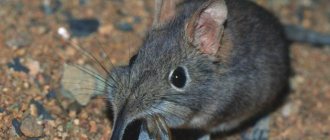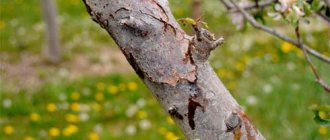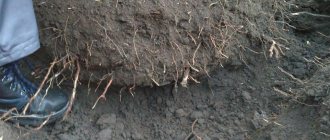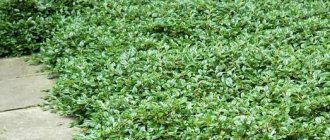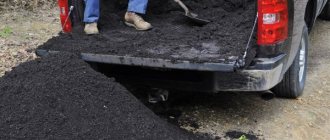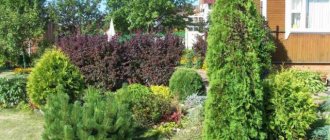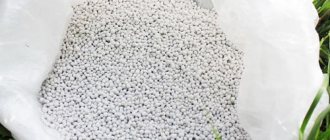A clean, tidy and well-groomed lawn - just like in the movies - is the dream of any gardener. But where you can see the excellent condition of the lawn, there is a lot of time and effort spent on caring for it.
Dear readers! For you, we have created communities on social networks in which useful articles and interesting ideas are published several times a day! Subscribe and receive useful content in a convenient format!
You don’t need to be an expert to understand for sure that the lawn should be watered correctly, trimmed on time and fertilized properly. And in between these main stages of care, include weed control. One of these weeds is considered to be moss, which readily settles on short grass and spoils the overall appearance of the lawn.
This article is a quick and useful way to learn all about the reasons for the appearance of moss on lawns and the most effective known methods of combating it.
Why does moss appear on the lawn?
It is better to start solving any problem by understanding the causes of its occurrence. At a minimum, this will help remove some unfavorable factor and prevent the situation from reoccurring in the future. Also, accurate knowledge of the reasons allows you to choose the right tactics for subsequent actions and not harm your lawn.
Moss does not appear on the lawn due to one or two factors of improper care. There are, of course, many more real reasons.
- First, moss can often be found in areas where there is a lot of shade.
- Secondly, moss readily grows in lowlands where humidity is high.
- Thirdly, the lawn looks worse and more weeds grow on it when the soil is highly acidic.
- Fourthly, poor soil composition may have an effect. Lawn grass will be stunted and slowly growing, but upright mosses will feel real freedom for themselves.
- Fifthly, the active spread of mosses is affected by poor air permeability of the soil. As a result, the soil becomes damp and damp, which is ideal for moss.
- Finally, the “human factor” can also have an impact. If you do not properly care for the lawn, in particular mow it low and often, then after a while a cushion of moss will form under the layer of grass.
AND FURTHER. Sometimes moss appears on the lawn not for one reason alone, but because of a whole combination of these factors.
But in all cases, you can adjust the care of your lawn and create unfavorable conditions for the appearance of moss. The most important thing is to follow the exact recommendations and not deviate one step from the action plan.
Reducing humidity
The reason for the lawn to become overgrown with moss may be due to increased moisture levels. You can prevent the soil from becoming waterlogged even at the design stage by providing a drainage layer . If water still stagnates in the soil or there is no drainage, the problem can be solved by loosening the soil with a fine-tooth rake. Then you need to pour a layer of sand up to 1 cm. In the future, you should abandon night watering, and reduce daytime soil moisture by half.
Did you know? Different types of moss are found on all continents, including Antarctica.
Mechanical methods of controlling moss on the lawn
The main method of mechanically collecting moss from a lawn area is to loosen the soil and collect the remaining grass with a garden rake. At this very time, the emerging moss is also removed. It has a very weak root system, which is why the weed is easily removed from the ground.
Often, amateurs prefer simple manual moss removal. But this is not very convenient if the area is too large, and there are many places favored by this weed.
And we must remember that mechanical processing must be carried out extremely carefully. In the worst case, you will simply damage the top layer of soil and remove the moss along with the lawn grass. As a result, you will end up with a huge number of uneven spots and bald spots on your lawn.
Mechanical removal
The easiest method for controlling moss is to destroy it manually. The root system of the weed is short, so it is easy to remove. To improve the condition of the lawn, you need to rake the surface . There are also fine, short tine cultivator kits available for sale that can be used for this purpose. Thus, you can not only get rid of the problem, but also fluff up the soil. After such simple aeration, the access of oxygen, moisture and nutrients to the roots of lawn grass improves.
Liming and deoxidation of soil from moss on the lawn
An increase in soil acidity can occur for various reasons. Firstly, due to the natural presence of chemical elements and acids in its composition. Secondly, due to improper use of feeding mixtures.
But you always need to deoxidize the soil for better lawn growth. Do this even for routine prevention, without any signs of severe acidification. For example, in the spring, add lime or wood ash to the area (the best is coal from coniferous trees), evenly distributing them in a thin layer.
After this procedure, it is not recommended to walk on the lawn for 2-3 days. And it is advisable to adjust to the weather forecast so that there are no heavy downpours in the next 2 days.
There are many ways to determine high soil acidity. The most accurate is laboratory analysis. You can take some of the removed turf to the laboratory.
But there is also a folk method. People say that in soil that is too acidic, moss grows with long green shoots, but closer to the roots they are red.
The main reasons for the appearance of moss on a summer cottage
This plant tends to spread quite quickly, thereby infecting nearby structures and areas with its spores. In addition to aesthetic damage, moss can cause great harm to vegetable and garden crops. It is able to absorb a large amount of useful components from the earth, as well as moisture. And this, in turn, inhibits other plant organisms. Gradually they die, and moss occupies large areas.
Fruit trees that are covered with moss grow much slower, practically do not produce fruit, and as a result, their branches dry out and then die. In addition, moss growths are an optimal habitat for various parasitic insects.
The main reason moss appears in the most unexpected places is acidic soil. It also grows in shaded areas with excess moisture. Perhaps you will not find it among tall crops, since they impede ventilation.
When this plant appears in your garden plot, you should check the soil for acidity level, since moss usually lives in acidic soils.
How to fight with chemicals
Lawn grass is a delicate creature. Therefore, chemicals should be used strictly according to the manufacturer’s instructions, and sometimes even in concentrations less than recommended.
The most common chemicals used to control moss are herbicides.
But such an approach is also relevant: it is better to try to fight with folk remedies (for example, iron sulfate), or give preference to targeted mechanical treatment of moss. And only then, if nothing really helps, then move on to “heavy artillery.”
How to destroy moss on fruit trees
It is recommended to carry out activities for cleaning fruit crops in early spring, before the buds swell on the trees, as well as in late autumn, after the final harvest:
- To destroy moss, trees must be treated with the following means. A five percent solution of iron sulfate is made in the ratio of 1 liter of water to 50 g of the substance, followed by processing of the wood. After seven days, the mosses will fall off on their own. But if some part remains, it is recommended to remove it mechanically;
- in the case when almost all fruit crops are affected by moss, it is necessary to carry out sanitary cutting before cleaning. In addition, it is recommended to carry out systematic thinning pruning of garden crops.
Elimination of high humidity
It is necessary to water the lawn, but for its good growth it requires a properly functioning drainage system or properly selected loose soil, as well as the absence of places where moisture could accumulate for a long time.
If there are blockages in the excess water drainage system, obviously they need to be eliminated as quickly as possible.
When there are hollows or holes in the area, it is recommended to fill them with sand or clay, thus leveling the area. Yes, this is not the most aesthetic way out of the situation, but soon you will achieve better condition for your lawn when new grass grows in the filled areas if you sow it right away.
Well, if the weather is very damp, then they also fight the humidity using such a method as scattering sawdust. They absorb some of the moisture and leave less chance for moss or other weeds to grow.
Control measures
So, the reason has been established: what actions, in addition to eliminating it, need to be taken to remove the moss covering from the area.
First, it is necessary to saturate the soil with oxygen, for which an aeration procedure is carried out. This procedure is carried out by piercing the top layer of soil along with the turf (forks). This ensures air access to the grass roots and optimal moisture exchange is established. Then you need to feed the grass with fertilizers. But the information at the link will help you understand how to choose the right sprinkler for watering your lawn.
It is best to use nitrogenous compounds as fertilizers, as well as iron sulfate. Often the reason for the rapid spread of moss throughout the area is the high content of phosphorus in the soil. Therefore, it is not yet recommended to apply formulations with this mineral. And sometimes you have to use quite serious herbicides to thoroughly poison the soil, discouraging any desire for moss to spread in a given place.
Video: how to fight weeds and remove them from the ground in the garden
The video shows the most effective methods of struggle:
If acidity is elevated, take measures to neutralize the acid balance. To do this, you can water the ground with water with ash dissolved in it. In addition to ash, liming the soil can also help eliminate high acidity. To do this, take garden lime and mix it with sand. All areas affected by moss should be sprinkled with this mixture. It is important to carry out the procedure in dry weather so that rain does not wash away the lime from the soil.
If it turns out that the reason for the spread of moss was the location of the site in a lowland, it is necessary to level the terrain by filling the lowland with soil. It is important that the brought soil contains a fair amount of sand, which moss really does not like. Here's what sprinklers you should use to water your garden and how to install them yourself.
Watering of this area should be limited. If moss covers a large area of the lawn, then it is best to stop watering altogether. Sprinkle sand on the surface of the soil - this measure will help improve soil drainage. To quickly remove moisture from the area, make as many grooves as possible where water can drain. This way you can dry the area in a short time.
If the area is shaded due to trees growing nearby, it is recommended to trim their crown to allow more sunlight to reach the grass.
Important: take measures to remove moss in the fall, when the plants are already ready for winter. If you “treat” your lawn correctly in the fall, having precisely established the cause, then by spring, after the snow melts, you will find that the problem has been resolved.
How and what herbicides to use
Herbicides can be considered the most effective way to combat moss. There are several options to choose from.
They must be used strictly according to the manufacturer's instructions, as they contain substances that can burn the grass. For the most part, the products are either sprayed over the lawn or their granules are scattered along with the regular fertilizer.
After application, you should not walk on the lawn for several days. And after 2-3 days, water the lawn (if there has been no good rain during this time).
Now you can walk through the area with a rake and collect the dead moss.
General herbicides
As a rule, they contain iron sulfate - a real threat to mosses.
The best time to use general herbicides is spring and summer. Its effect is usually quite mild. The main direction of exposure is lawn leaves. The product has no effect on the roots.
Herbicides specifically against moss
These formulations already contain dichlorophen. This substance has a more serious effect on all lawn grass and, accordingly, moss.
Such herbicides are not recommended to be used immediately, but are advised to first give preference to mild agents. And, if all else fails, move on to special herbicides. For this reason, it is best to apply a moss herbicide in late summer or fall at best.
Methods of disposal
There are several methods for controlling moss, and they all involve physical or chemical action on the plant. This is natural, because it must be completely destroyed, otherwise the lawn grass will die. Physical moss removal involves removing the moss using scarification. The best way to do this is to use a rake.
In a small lawn, moss raking can be done by hand, carefully removing moss and other organic materials. On a large lawn, removing moss by hand can be very time consuming. Therefore, it is better to use a special lawn mower blade for these purposes. In this case, the teeth of the blade should only lightly touch the soil, otherwise the grass may be damaged. It is imperative to treat the lawn in this way before using chemicals to kill moss.
All chemical preparations for moss removal are available in the form of solutions and in the form of granules or powder. The lawn is treated with liquid herbicides using a watering can or sprayer. They are used to destroy plants in small areas. To apply herbicides in powder or granules, they are mixed with any fertilizer and sprinkled on the grass. Then after 1-2 days the lawn is watered. It is not recommended to cut the grass for several days. Also, this method cannot be used for grass that has been growing for less than 2 years.
One of the effective means for destroying a parasitic plant is a glyphosate-based herbicide. This substance is absorbed by plants and transferred to the soil. Glyphosate has a good effect on moss, but it must be used if nothing else grows on the lawn besides moss and grass. It is important to read the instructions before use.
A sulfate-based herbicide can be used for this purpose. They are not so popular but, nevertheless, effectively destroy moss. It is best to use products based on ferrous, copper or ammonium sulfate. The composition is diluted in the proportion of 90 ml of herbicide per 20 liters of water. This amount will be enough to treat a lawn of 300 square meters. m.
Soap is often used as a universal remedy for controlling moss on the lawn. This chemical solution is used infrequently as it does not have a long-term effect. However, it can be used to destroy small areas of the plant. It is best to use this soap during dry periods.
If the soil is highly acidic, it is necessary to carry out so-called liming. In this case, it is better to take lime directly on the basis of calcium in order to achieve quick results. It is necessary to use this product if the soil pH does not reach 6. When this indicator is above 7, it means that it is an alkaline environment, not an acidic one. In general, the norm for lawn soil is 6 to 7.
The procedure is carried out as follows. Lime must be thoroughly mixed with sand and sprinkled on top of the affected areas. This is all done exclusively in dry weather, autumn or winter. But there is no need to use this method often, since excess lime can cause irreparable harm to the grass.
Eliminating excess shadow
Sometimes the appearance of moss is facilitated by excessive shading of the area. If the lawn does not receive enough sunlight, the owner should get rid of the shade. The bushes can be transplanted to another place. The crown of tall trees that cannot be moved must be thinned out. Within a few weeks after such manipulations, the weed will stop growing across the lawn.
Did you know? In times of famine, residents of what is now Finland added moss to the dough when baking bread.
Chemical means for control
Specially developed preparations show a good effect in getting rid of moss. Concentrated ferrous sulfate is considered one of the most effective. To treat the area, you need to dissolve 5 ml of raw material in 1 liter of water. The specified amount is enough to irrigate 15 m² of lawn. Spraying with a solution of copper sulfate will also be effective .
Important! Treatments are carried out using a sprayer. So a small amount of the drug is enough to irrigate a large area.
It is necessary to prepare the product at the rate of 10 ml of concentrate per 1 liter of water. This amount will be enough for 20 m² of lawn. Treatment with iron sulfate at a concentration of 5% will be effective. 100 m² are irrigated with 5 liters of working fluid. After spraying, after about 5 days the moss will turn black - this indicates its death.
Mechanical removal
The easiest method for controlling moss is to destroy it manually. The root system of the weed is short, so it is easy to remove. To improve the condition of the lawn, you need to rake the surface . There are also fine, short tine cultivator kits available for sale that can be used for this purpose. Thus, you can not only get rid of the problem, but also fluff up the soil. After such simple aeration, the access of oxygen, moisture and nutrients to the roots of lawn grass improves.
Weed control
Moss is a weed and often grows together with other pests. To get rid of the problem, the owner should weed out all pest plants. In addition to moss, these can be dandelions, bluegrass, buttercups, plantains, clover . They should be removed manually or using a weeding device. Herbicides can also be used. All drugs listed in the table below are used once.
| Means | Consumption | Application time |
| "Lintur", Syngenta | For 40 m³ - a solution of 0.75 g of powder and 2 liters of water | In the tillering phase |
| "Clean Lawn", Belreakhim | For 100 m² - a solution of 1.4 g of dry preparation and 5 liters of water | 3 days after haircut |
| "Lontrel", August | For 100 m² - a solution of 6 ml of concentrate and 5 liters of water. | During the growing season of weeds after the first mowing |
Soil deoxidation
It is necessary to determine the pH and nutrient content of the soil. If this is not possible, then there is no doubt that the mere presence of moss is an indicator of high soil acidity. It is desirable that the lawn grass competing with moss tolerates an alkaline environment well. A healthy lawn will require liming the soil and feeding it with organic fertilizer, compost, manure or other organic matter. Lime must be applied 2 times during the growing season.
- How to deoxidize the soil on a plot - useful tips for gardeners and gardeners Acidic soil on a plot can destroy many plants and negate all efforts to grow them. How to correct soil acidity in beds and gardens?
Loosening the soil
The second step is to loosen the compacted soil. Moss has shallow roots, so raking it out won't be too difficult. Use a rake to vigorously remove moss from the entire surface of the lawn, this will improve aeration. A fine-tooth rake or lawn mower blade is ideal for this job.
Application of herbicides
Mechanical control of moss can be replaced with chemical control. Any glyphosate-containing herbicide will do, as will ferrous or ammonium sulfate. The working solution is prepared at the rate of 90 ml of iron sulfate per 20 liters of water or 60-150 ml of copper sulfate per 16 liters of water. This solution can treat approximately 300 sq.m. Many people use a solution of soda, soap or dishwashing detergent to combat moss. To do this, dissolve 200 g of baking soda in 2 liters of warm water and spray it onto the area. But this method will only give a temporary effect.
Reducing soil moisture
Combating excess soil moisture is another way to get rid of moss on your site. There may be a drainage problem in the area. In such areas, water tends to slowly seep through clay soils. In this case, the soil needs to be loosened and its structure improved by adding sand and humus.
To prevent the appearance of moss after mowing the lawn, remove the thatch immediately. A thick layer of thatch can prevent water from penetrating through the soil and preventing water from evaporating from the soil surface. You should also avoid overwatering your lawn. You should especially avoid watering at night, in early autumn or spring; moss grown during this period is the most resistant.
- What to do if your dacha plot is damp? Do you have a damp dacha plot? No problem! We will show you how to correctly correct this deficiency.
How to use iron sulfate
Among the folk methods of combating moss on the lawn, iron sulfate often appears. In addition, it will help in the fight against other fungal diseases of the soil, if any.
Dilute the product as follows: bring it to a concentration of 5% and use it, spraying it evenly over the entire area. Approximate consumption: 2-3 liters per 50 m2 of area.
And remember the processing rule. Iron sulfate should be applied after the next mowing of the lawn. After 2 weeks, collect dead moss and repeat the procedure again.
Fertilizers
Only a regularly fertilized lawn looks bright green and healthy. Bryophytes are rarely found on “healthy grass”; there is simply no place for them. Not only products with ferrous sulfate are available on the market, but also lawn fertilizers with moss, in which this substance is one of the components. In addition to ferrous sulfate, which inhibits moss growth, these formulations contain the following nutrients that have a positive effect on grass growth:
- nitrogen;
- boron;
- copper;
- manganese;
- zinc.
Using lawn fertilizers with moss has a double effect:
- helps remove moss;
- strengthens the grass, improving the turf, making it thicker and stronger.
To ensure a permanent effect, fertilizer and ferrous sulfate should be applied regularly according to the manufacturer's instructions on the product label.
Fertilizing the lawn should be preceded by a soil analysis (composition, acid reaction). Then you can reliably determine what fertilizers need to be used and in what doses. Using fertilizers “by eye” can lead to oversaturation of the soil with nutrients and oppression of plants.
It is advisable to use granular mineral fertilizers with an extended period of action (nutrients are released from the granules within 3 months).
Acid Soil Problem
Moss is more likely to appear on lawns located in acidic soils with a pH below 6. When controlling, it is worth checking the pH of the soil. The check is performed using the following means:
- special electronic soil tester (acid meter);
- litmus paper;
- ready-made tests for soils.
If the result indicates acidic soil, moss appears on the lawn, it is worth liming. The operation changes the soil pH to alkaline and helps remove bryophytes. For liming it is better to choose:
- lime in the form of ground chalk or dolomite, wood ash;
- Calcium-magnesium fertilizer is dispersed on the surface of the lawn and gently watered with water.
Dolomite flour is a fertilizer formed by grinding calcium-magnesium rocks. Dolomite flour replenishes the soil with micronutrients and changes the soil reaction to a more favorable one. Dolomite allows you to increase the alkaline reaction; it is used after the end of the growing season, in late autumn, even in winter on snow. Water will speed up the dissolution of dolomite; this is a rather lengthy process. Dolomite works slowly, but after a month of the growing season the beneficial effects of its use are noticeable.
Regular wood ash from the fireplace will help fight moss. There is a well-known method among gardeners when areas overgrown with mosses are sprinkled with wood ash sifted through a sieve and then moistened. This is a simple home way to combat moss, the reviews of which are quite good.
Note. Ash from burning unpainted wood is used. Ash from coal or ash from wood burned with the addition of cardboard, printed paper, fabrics, plastics is not suitable for fertilizer!
Why use wood ash? Ash has a crushed structure, so plants have no problems obtaining minerals. Ash works slowly, unlike other mineral fertilizers, and has a fairly balanced composition. The ash reaction ranges between pH 11-13 and perfectly reduces soil acidity. Due to its natural composition, wood ash is used in environmentally friendly agriculture.
Preventive measures against moss on the lawn
Let's not forget that sometimes it is not enough to properly care for your lawn, but it is advisable to take some measures to prevent the appearance of moss.
To do this, it is recommended to perform only two steps:
- Feed the soil in a timely manner and in the correct proportions over the entire area.
- Mulch the surface of the area with a lawn, and, if possible, also ensure good aeration of at least the upper layers of the soil.
If you take these two simplest methods of prevention as a weapon, then you can surely say that the lawn will smell fragrant and look perfect in any weather.
Timely application of fertilizers
So, proper care begins with increasing the fertility of your soil.
Why is it so important to fertilize your lawn grass frequently? Because for the sake of a pleasant appearance, it has to be cut, and all the rubbish (meaning dry grass residues) has to be removed. All this greatly depletes the soil of its content of useful micro- and macroelements for grass growth.
You should start fertilizing the area where the lawn will grow in early spring.
- For the first time, all liquid-based fertilizers are suitable. It is good to use nitrogen-containing mixtures - they significantly improve grass growth, which means your lawn will sparkle with color earlier. The intervals between applications should be 2-3 weeks.
- Fertilizing is applied at approximately the same frequency throughout the summer. Only this time you can alternate nitrogen fertilizers with mineral ones.
- In the fall, while it is warm, you can continue to fertilize frequently, once every 3 weeks. But you should avoid nitrogenous mixtures altogether - nitrogen promotes growth and active pumping of nutrients from the soil by the grass. Meanwhile, we need to think about winter. Therefore, it is recommended to apply fertilizers based on potassium or phosphorus starting from the second half of September. This way the grass will be better able to withstand frosts, which occur at night already in October.
It is better to apply fertilizing in the early morning or evening. If you do this in sunny weather or after rain, the sun's rays can burn the leaves of the lawn and ruin its appearance.
ON A NOTE. But even without applying fertilizers, experienced gardeners advise taking 1-2 weeks a year as a practice and not removing dried grass from the lawn at all. This will fill the soil with natural organic residues, which will benefit the growth of the lawn.
Mulching the soil
Just don’t forget about mulching and aerating the lawn soil. It's not even necessary to do it deeply. But the stage itself is necessary for the reason that moss, as a rule, has very superficial roots, lying only 1-2 cm deep into the soil. By lightly loosening the lawn area, you can get rid of incipient moss, including mechanically.
Standard aeration, for example, is enough no more than 1-2 times a season. The first time can be done in early spring, and the second time towards the end of summer.
For small lawn areas, a rake or fork will suffice. It is quite easy to pierce the lawn 1-3 cm in identical rows over the entire area, maintaining a distance of up to 8-10 cm between the rows.
If we are talking about a large area, then professional aerators are usually used for this. They are sometimes built into some expensive lawn mowers, but manual models are also available.
How to prevent moss from appearing?
- On hard-to-permeable, compacted soil - before sowing grass seeds, you need to loosen the soil by mixing the top layer of soil with sand.
- In places with flooding and puddles. In areas where puddles form easily, consider subsurface drainage (with a drainage system) or surface drainage (with a layer of gravel or expanded clay under the soil in which the lawn will grow).
- In wet soils, shaded, north-facing areas, it is worth considering using the right seed mixture. Suitable varieties are slow-growing, shade-tolerant grass that creates dense turf that is difficult for mosses to colonize.
- On a finished lawn, it is necessary to loosen the soil by sprinkling it with a thin layer of sand and gravel, and regularly aerate it. By piercing the lawn with a garden fork, the moisture content of the substrate is reduced, preventing the growth of moss. It is necessary to perform scarification 1-2 times annually - vertical cutting of the turf, removing dead parts of plants from the lawn, the grass becomes better nourished and stronger.
After scarifying the lawn, it is necessary to carefully rake the remains to remove mosses and dry grass. Aeration is effective - saturating the turf with oxygen. The treatment is designed to improve the physical properties of the soil, thanks to which fertilizers, water, and air better reach the roots.
Aerating the turf promotes better grass growth and compaction of the lawn. In a healthy, dense, compact lawn, bryophytes are rare.
Proper lawn care includes the following:
- The lawn should be mowed regularly (once a week), in shaded areas the grass should be cut to at least 5 cm in height, and not watered too often.
- You should fertilize your turf 3-4 times a year using appropriate lawn fertilizers.
- Cleaning the turf is extremely important, especially in the fall, when leaves fall from trees, shrubs, and broken dead parts of other plants.
- To get rid of moss, you need to ensure proper underground or surface drainage.
Proper watering
During drought, mossy plants develop poorly; in a humid environment, their development gains momentum, so it is necessary to water the lawn less often, but more abundantly, and not often and little. As a result, water will penetrate into the deeper layers of the soil, from where grass uses it; short rhizoids of bryophytes will not have access to moisture. The same applies to exposure to the sun - bryophytes dry out quickly in the sun, but grow well in the shade.
If an automatic irrigation system is installed, it is worth investing in a rain sensor to regulate the water supply. Thanks to the sensor, when the amount of precipitation is high enough, the area will not become waterlogged.
Answers to frequently asked questions
What to do if part of the lawn is in the shade and is not growing well?
Plant special shade-tolerant varieties of lawn there. Take a closer look at meadow bluegrass or red fescue.
How to reduce the moisture in the lawn when it rains often?
Sprinkle sawdust in an even layer.
Do I need to treat my lawn with herbicides for prevention if moss does not grow?
It is worth treating the lawn to remove moss, but it is better to give preference to mild means rather than herbicides as a preventive measure.
Eliminating excess shadow
Sometimes the appearance of moss is facilitated by excessive shading of the area. If the lawn does not receive enough sunlight, the owner should get rid of the shade. The bushes can be transplanted to another place.
The crown of tall trees that cannot be moved must be thinned out. Within a few weeks after such manipulations, the weed will stop growing across the lawn.
Did you know? In times of famine, residents of what is now Finland added moss to the dough when baking bread.
Conclusion
Moss on the lawn is a very common occurrence. We can confidently say that this is the most frequent guest on well-groomed, beautiful lawns.
But, as we were able to see, there are ways to get rid of it. Of course, most of them consist in a simple rule - it is better to carefully monitor the lawn and care for it professionally. Then moss is unlikely to appear.
But even if for some reason moss still spoils the appearance of your lawn, know that you can cope with the problem. You can get rid of moss using both mild but effective folk remedies and special herbicides.
Elimination of causes
Physical or chemical cleaning of the lawn from moss is an effective remedy, but it should always be supplemented by eliminating the causes that lead to the appearance of the pest:
- leveling the surface of the lawn will help prevent the regrowth of moss; it is necessary to level all the depressions and holes using special mixtures of leaf humus and sand to improve soil drainage
- performing aeration - in small areas it is enough to make holes in the soil using a fork; large lawns need ventilation provided by a special aerator
- Liming is required when elevated soil acidity levels are detected (if acidity is at least 5.5), you should purchase calcium-based lime, mix it with sand, and then sprinkle the prepared mixture on all mossy areas on a dry, windless day (best in autumn)
- replacing grass for a lawn is necessary in cases where the reason for the growth of moss lies in the lack of natural light and it cannot be solved in other ways; you can sow the area with less light-loving grasses (red fescue, meadow grass, hosta)
- fertilization – it is necessary to ensure the correct application of nutrients according to the seasons followed by watering:
- autumn - Diammofoska with potassium and phosphorus (2-3 kg per 1 hundred square meters)
- spring – Nitroammophoska with nitrogen, potassium and phosphorus (3 – 3.5 kg per 1 hundred square meters)
- summer - Floranide with a high nitrogen content (3-5 kg per 1 hundred square meters)
- proper mowing of the lawn - in warm and humid weather it is necessary to trim it once a week, and on dry and cold days - once every 2 weeks, you should also focus on the height of the growing grass, which ideally should not exceed 5 cm
- ensure regular irrigation and watering - the lawn should be watered at least 3 times per week, in hot, dry weather this amount should be increased and it is best to water the lawn in the evenings, and with enough water so that puddles do not form
If you notice repeated appearance of moss on your lawn, you should consider reviewing your site plan. It is necessary to trim wide, dense bushes and tall trees and move large objects. This will help ensure the flow of light into the lawn. It is useful to regularly comb the lawn with a rake.
One of the popular questions among gardeners and gardeners is moss on the lawn, how to get rid of it, they are often asked on forums and looking for an answer, since everyone knows that the appearance of moss on the lawn threatens the loss of its beautiful appearance and the possible death of the grass. And although it is quite difficult to fight moss, the measures listed above can successfully get rid of the unpleasant pest. And then you can again admire the beautiful emerald view of the spacious carpet in front of the house.
Copper sulfate
Among the effective methods that do not require large financial costs is the treatment of lichens with a solution of copper sulfate. It is prepared from 350-500 ml of product and 10 liters of water.
A solution of vitriol is collected, for example, into a sprayer for treating trees against pests and then applied to the roof from the top ridge down. It is advisable to clean the roof with a mini-wash or other mechanical method before doing this. If you fight moss without preliminary cleaning, then copper sulfate will have to be applied several times in a row for greater effectiveness.
Moss and lichen: what is the difference
Sometimes people, seeing various kinds of growths in the form of moss on a tree, say: there is a lichen. But moss is not a lichen . Mosses are real plants, although they have a simpler structure. They do not have roots (they are replaced by hair-like processes - rhizoids), but they have stems and leaves, albeit small ones. The leaves contain chlorophyll, so mosses produce their own nutrients from water and carbon dioxide. Additional nutrition comes through the rhizoids.
When moss finds itself in conditions that are uncomfortable for it, it goes into suspended animation, where it remains until the factors that promote the development of mosses return.
Moss reproduces by spores . They are instantly spread by wind, rain and insects. Therefore, having “colonized” one tree, moss quickly colonizes neighboring crops, giving the garden an unkempt appearance.
Lichens belong to the kingdom of fungi , but despite their fungal origin, they live, like plants, thanks to photosynthesis. The fact is that they represent a kind of biological complex formed by the cohabitation of fungi and algae. Mushroom hyphae make up the lower and upper crust, and in the middle, like filling in a pie, algae “sit.” They do photosynthesis.
Interestingly, forcibly separated components are able to exist independently. Fungi take nutrients from algae. In addition, they are able to move plant cells closer to the light. However, when faced with unfavorable conditions, each organism is responsible for itself.
The algae are preserved, as it were, for a long time, and the mushrooms continue to exist, absorbing water from the fog and receiving the necessary mineral salts along with dust and rainwater.
Lichens are extremely common and tenacious organisms. They are able to survive in conditions that are harmful to most living organisms. And about a dozen different species can live on one tree trunk.
